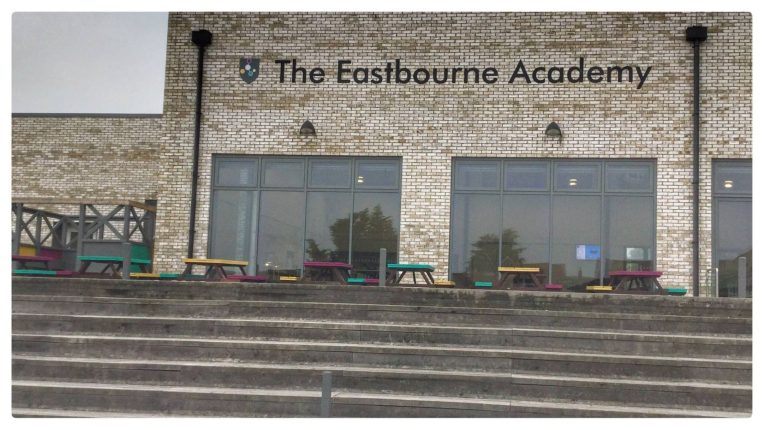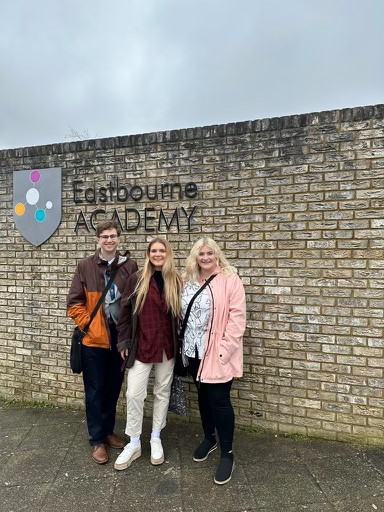Three students, Jayda Lochner, Lindsey Knapp, and Cole Merkin from Illinois State University’s history-social sciences education program headed to Eastbourne, England, to experience teaching at an English school. The students first taught for almost seven weeks at high schools in Illinois. When they arrived in England, they met their host families, other students from different majors, and their university and placement supervisors. The following week, they began a two-week orientation at The Eastbourne Academy (TEA) before beginning their student teaching.
Each student has written about their experiences teaching abroad.
Lindsey Knapp: Building relationships in 10 weeks
As my plane landed at London’s Heathrow Airport, the reality of my situation fully sunk in. Here I was, in a foreign country, knowing next to nothing about what lay ahead of me. Thanks to the two weeks of orientation, I began to acclimate to the English education system before entering the classroom. I was primed on the national curriculum, the background of the school, and their daily procedures, during which time I learned that I would be teaching history to all grade levels.
The daily timetables are the most jarring difference between American and English schools. In the United Kingdom, students have different class schedules every day. Because history is not a core subject, I would only see my students a few times a week, depending on their age and if their class is split between two teachers. Initially, this was frightening. I was going to be at the school for 10 weeks. Accounting for strike days and Easter holidays, I would only have some students in class six times, leaving me unsure if I could build relationships with students in such a short amount of time.
In retrospect, this proved not to be an issue. I quickly bonded with my students by capitalizing on my American novelty and continuing interactions outside of the classroom. As soon as it clicked that I was an American, students displayed an almost overwhelming sense of curiosity. They wanted to know how Chick-Fil-A tasted, if I had ever visited Ohio, and, of course, if I owned any firearms. The questions never stopped—even up to my last week, students still wanted to know tidbits about my life at home. Although it was clear that students were trying to avoid doing their work by conversing with me, I always provided them with some sort of response. Not only did I randomly show up in the middle of their term, but I also spoke with a foreign accent. When I eventually moved from observation to instruction, I wanted to ensure that students were comfortable with my presence. Entertaining students’ inquiries enabled them to see me as a real teacher, not just a visitor.
This approach to relationship-building had academic applications as well. Discussion of topics like Chicago-style pizza broke the ice so that students could later ask tough questions about the slave trade or the Holocaust. Students were curious about life in America. Taking advantage of this interest, students quickly adapted to my roles both in and outside the classroom. Some of my favorite memories of my time overseas were created by attending student events. In one instance, I went to the dance team’s performance. The dancers were lined up in the hallway as I entered the seating area. I fondly remember hearing excited voices exclaiming, “Ms. Knapp is here!” and receiving waves from dozens of students, and after this performance, I noticed that the students who were a part of this team were raising their hands more in class and generally more engaged in the lesson. Even though I had limited class time with students, I made the most of it by supporting them in their extracurricular activities.
My student teaching experience was admittedly non-traditional, but by teaching in classrooms in Illinois and England, I understood the universality of certain teaching truths. I had to immediately dive into forming relationships with the students at both placements. No matter who your students are, they must know you care about them. After my time in England, I can confidently say that even six class meetings across 10 weeks are enough to develop a strong rapport with students.
Cole Merkin: Dressing the part
When I got to TEA, I had the exciting opportunity to start teaching within my first week. This allowed me to become a staple in the classroom really quickly—students were expecting to see me when they came into class every day. My cooperating teacher was the head of the history department and also taught a geography class.
As I was allowed to teach most of the lessons each week, I became known (at least to some of my students) as “that funny American man.” This was in part due to my intentionally humorous teaching style, and in part due to my choice of ties. In England, the dress code for students and teachers is much stricter than in the U.S. I was expected to wear a suit coat and a tie to school on a daily basis. Conveniently, I’d been preparing for this for years. I have a collection of around 17 ties that I’ve collected over the years, and I used them to lighten up my wardrobe a bit. Some student favorites included my gummy bear tie and my Kermit the Frog tie—students really seemed to enjoy them.
Regardless, I learned a lot about the differences between the two school systems. I got a lot of good lessons regarding lesson and curriculum planning, as well as classroom management, and I managed to build great relationships with my students and coworkers in the process!
Jayda Lochner: A truly unique experience
My experience at TEA was a little different than my peers. I was originally in a classroom with a teacher teaching philosophy, religion, and ethics. However, with multiple things not lining up well, I decided to contact my advisor to get switched to an area of the school better suited for me to grow and learn at the school. For most of my time at TEA, I worked in the Teaching and Learning Center, an inclusive room for students of special education needs and disabilities and social emotional mental health to complete their schoolwork outside the traditional classroom. In this room, I worked one-on-one with students on whatever subject they had during class. This experience taught me much more about behavior management and diversity than I would have experienced in a traditional classroom. For that, I am incredibly grateful.
My time in Eastbourne was highly enjoyable. Although I did not get traditional classroom experience, I will take all the lessons I have learned from my time at The Eastbourne Academy into my future endeavors. As a history person, being in England was amazing with all the fun field trips around southern England we did. Thanks to all who made this trip possible and memorable!


